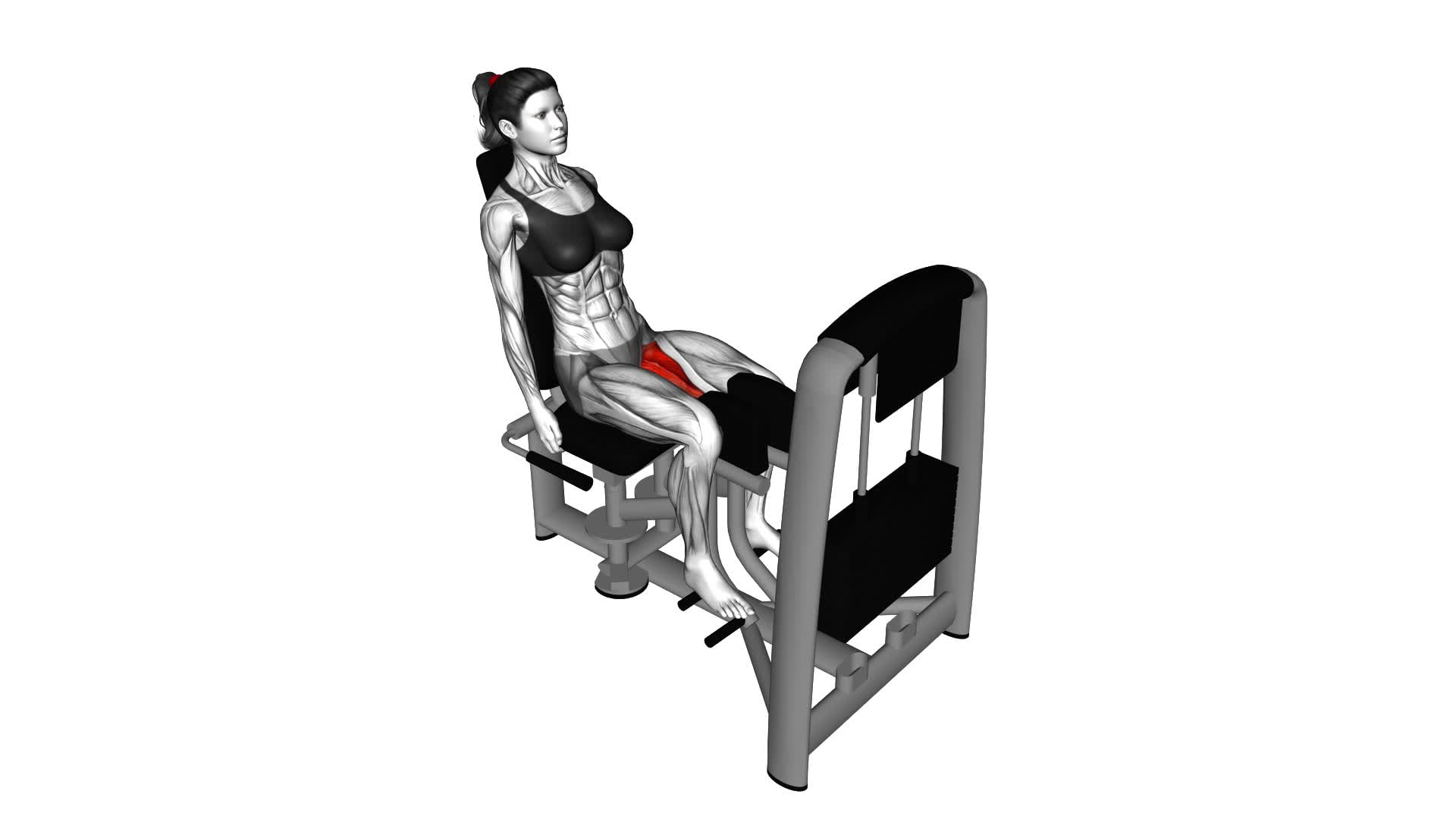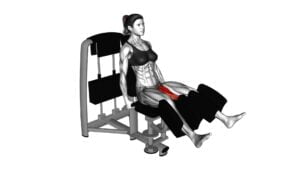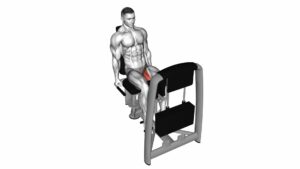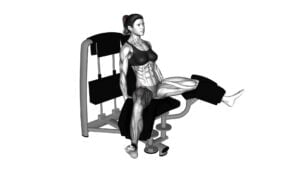Lever Seated Hip Adduction (female) – Video Exercise Guide & Tips

Looking to tone your inner thighs? Check out this video exercise guide on Lever Seated Hip Adduction!
Watch This Exercise Video
In just a few minutes a day, you can target and strengthen those hard-to-reach muscles. This exercise is perfect for females of all fitness levels.
Learn the proper form, equipment set-up, and variations to maximize your results. Avoid common mistakes and get ready to see those thighs transform with this effective workout.
Let's get started!
Key Takeaways
- Lever seated hip adduction improves hip stability, balance, and overall body stability.
- It targets and strengthens the hip adductor muscles, reducing the risk of falls or accidents.
- Proper form and technique are crucial, including maintaining a straight back, engaging core muscles, and avoiding jerking movements.
- Common mistakes to watch out for include rounding the back, using too much weight, and neglecting proper form and alignment.
Benefits of Lever Seated Hip Adduction
Discover the benefits you can experience by incorporating lever seated hip adduction into your workout routine.
Strengthening your hip adductors has numerous advantages for your overall fitness and well-being.
One major benefit is improved hip stability and balance. When your hip adductors are strong, they provide greater support to the hips, which helps in maintaining proper alignment and preventing injuries. This is particularly beneficial for athletes and individuals who engage in activities that require lateral movements, such as running, dancing, and playing sports.
Additionally, strong hip adductors contribute to improved overall body stability. They play a crucial role in maintaining balance and posture, especially during movements that involve one leg at a time, like walking or standing on one leg. By targeting and strengthening these muscles through lever seated hip adduction exercises, you can enhance your overall stability and reduce the risk of falls or accidents.
Furthermore, having strong hip adductors can also have a positive impact on your athletic performance. These muscles are involved in various movements, such as jumping, lunging, and changing direction quickly. By developing strong hip adductors, you can generate more power and efficiency in these movements, leading to improved performance in sports and other physical activities.
Incorporating lever seated hip adduction exercises into your workout routine can bring about these benefits and help you achieve greater hip stability, balance, and overall fitness.
Proper Form and Technique
To perform lever seated hip adduction correctly, position yourself on the machine with proper alignment and engage your hip adductor muscles. Here are some tips to ensure you maintain proper form and technique during this exercise:
- Sit on the machine with your back straight, shoulders relaxed, and feet flat on the footrests.
- Adjust the machine's lever so that the pads are positioned just above your knees.
- Hold onto the handles on the sides of the seat for stability.
- Slowly squeeze your legs together, using your inner thigh muscles to bring the pads towards each other.
- Avoid using momentum or jerking movements to complete the exercise.
Common mistakes to watch out for include:
- Allowing your back to round or slouching forward during the movement.
- Using too much weight, which can compromise your form and increase the risk of injury.
- Not controlling the movement and letting the weight stack slam back down.
- Failing to engage your hip adductor muscles fully.
To improve your technique, focus on maintaining a slow and controlled movement throughout the exercise. Concentrate on squeezing your inner thighs together and feeling the contraction in your adductor muscles with each repetition. By practicing proper form and technique, you'll maximize the effectiveness of the lever seated hip adduction exercise and minimize the risk of injury.
Now that you understand the proper form and technique, let's move on to the next section about the equipment and set-up of the lever seated hip adduction machine.
Equipment and Set-Up
To ensure proper form and technique during the lever seated hip adduction exercise, it's important to select the appropriate equipment and set it up correctly.
Choosing a lever machine that's specifically designed for hip adduction exercises will provide the necessary resistance and range of motion.
When setting up the equipment, adjust the seat height and foot pad position to ensure a comfortable and stable position for your body.
Proper Equipment Selection
Choose the appropriate equipment and set it up correctly for the lever seated hip adduction exercise. To ensure an effective and safe workout, consider the following equipment options and potential risks:
- Lever Seated Hip Adduction Machine: Look for a machine with adjustable resistance and comfortable padding for optimal support.
- Resistance Bands: Attach the bands securely to a stable structure to provide resistance during the exercise.
- Dumbbells: Use dumbbells to add resistance while performing the hip adduction movement.
- Ankle Weights: Fasten ankle weights securely to add resistance to the exercise.
When selecting equipment, prioritize safety and comfort. Ensure that the machine or equipment is properly adjusted to your body size and fitness level.
Always start with lighter weights or resistance and gradually increase as you build strength. Remember to maintain proper form throughout the exercise to minimize the risk of injury.
Correct Set-Up Technique
When setting up the equipment for the lever seated hip adduction exercise, make sure to adjust it properly to your body size and fitness level. This step is of utmost importance to ensure that you perform the exercise effectively and safely.
Common errors in the set-up technique include using the wrong weight resistance, sitting too far back or too close to the machine, and not adjusting the foot pads to the correct position.
Using the wrong weight resistance can either make the exercise too easy or too challenging, leading to ineffective results or potential injuries. Sitting in the wrong position can also affect the targeted muscle group and increase the risk of strain.
Therefore, taking the time to properly set up the equipment is crucial for a successful lever seated hip adduction exercise.
Variations and Modifications
Modify the lever seated hip adduction exercise by adjusting the weight resistance to challenge and progress your workout. Here are some variations and modifications you can incorporate into your routine:
- Change the weight resistance: Increase or decrease the weight on the machine to make the exercise more or less challenging. Start with a weight that allows you to perform the movement with proper form and gradually increase the resistance as you get stronger.
- Use different exercises for hip adduction: In addition to the lever seated hip adduction, you can try other exercises that target the same muscles. Some options include cable hip adduction, standing hip adduction with resistance bands, or side-lying leg lifts.
- Modify for injured individuals: If you have a hip or lower body injury, it's important to modify the exercise to avoid aggravating the injury. You can decrease the range of motion, use lighter weights, or choose alternative exercises that don't put excessive strain on the injured area.
- Incorporate unilateral movements: Instead of using both legs simultaneously, you can perform the exercise one leg at a time. This helps to isolate and strengthen each leg individually, improving balance and addressing any muscle imbalances.
Remember to consult with a fitness professional or physical therapist before making any modifications or trying new exercises, especially if you have any pre-existing injuries or conditions.
Common Mistakes to Avoid
To avoid common mistakes, consistently focus on maintaining proper form during the lever seated hip adduction exercise. Proper form is essential for maximizing the benefits of this exercise and preventing injuries.
One common mistake to avoid is using momentum instead of controlled movements. Many people tend to swing their legs, which reduces the effectiveness of the exercise and increases the risk of strain or injury. Instead, concentrate on slow and controlled movements, focusing on engaging the hip muscles throughout the entire range of motion.
Another common mistake isn't using enough resistance. It's important to challenge your muscles in order to see progress and build strength. Start with a weight that allows you to perform the exercise with proper form, but also feels challenging. Gradually increase the resistance as you become stronger.
Improper foot placement is also a common mistake. Make sure your feet are firmly planted on the foot pads and your knees are aligned with the machine's pivot point. This will help maintain stability and target the correct muscles.
Lastly, avoid rounding your back or hunching your shoulders during the exercise. Keep your back straight and shoulders relaxed throughout the movement. This will help maintain proper alignment and prevent strain on your back and shoulders.
Tips for Maximizing Results
To maximize your results with the lever seated hip adduction exercise, focus on incorporating these tips into your routine:
- Maintain proper form: Keep your back straight against the pad and engage your core muscles. This will help maximize the intensity of the exercise and prevent injuries.
- Start with light resistance: Begin with a weight that allows you to perform the exercise with proper form. Gradually increase the resistance as your strength improves, to continue challenging your muscles and maximizing results.
- Control the movement: Slowly bring your legs together, using your inner thigh muscles to squeeze the lever. Avoid using momentum or jerking motions to prevent injuries and ensure that you're targeting the correct muscles effectively.
- Include variety in your routine: While the lever seated hip adduction exercise is an effective way to target the inner thighs, it's important to incorporate other exercises that work different muscle groups as well. This will help avoid overuse injuries and promote overall balanced strength development.
Frequently Asked Questions
How Long Should I Perform the Lever Seated Hip Adduction Exercise to See Noticeable Results?
To see noticeable results from the lever seated hip adduction exercise, it's important to perform it for an optimal duration. Consistency is key here.
Aim for at least 2-3 sets of 10-15 repetitions, 2-3 times a week. This will help build strength and tone in your hip adductor muscles.
Can Lever Seated Hip Adduction Help in Reducing Cellulite on the Thighs?
Lever seated hip adduction can be beneficial in reducing cellulite and improving the appearance of your thighs. By targeting the muscles in your inner thighs, this exercise helps to tone and firm the area, which can reduce the appearance of cellulite.
Consistency is key, so make sure to perform this exercise regularly, along with a healthy diet and overall fitness routine, to achieve noticeable results.
Is It Normal to Feel Soreness in the Inner Thighs After Performing the Lever Seated Hip Adduction Exercise?
Feeling soreness in your inner thighs after doing the lever seated hip adduction exercise is normal. This exercise specifically targets the inner thigh muscles, so it's expected to feel some discomfort afterwards.
To alleviate the soreness, you can try alternative exercises that target the same muscles, such as side lunges or sumo squats.
Remember to listen to your body and give yourself time to recover before engaging in intense workouts again.
Can Lever Seated Hip Adduction Help in Improving Flexibility in the Hip Joints?
Lever seated hip adduction can be beneficial for improving hip flexibility. By targeting the inner thighs, this exercise helps to strengthen and stretch the muscles around the hip joints.
The repetitive motion of bringing your legs together against resistance can increase your range of motion and loosen up tight hip muscles. Incorporating lever seated hip adduction into your workout routine can contribute to better overall hip flexibility and mobility.
Are There Any Specific Precautions or Contraindications for Individuals With Knee or Hip Injuries When Performing the Lever Seated Hip Adduction Exercise?
When performing the lever seated hip adduction exercise, it's important to be aware of any knee or hip injuries you may have. There are specific precautions and contraindications to consider.
To prevent further injury, it's recommended to modify the exercise if you have knee or hip injuries. Consult with a healthcare professional or a qualified trainer to determine the appropriate modifications for your specific condition.
Safety should always be a priority during any exercise routine.
Conclusion
To conclude, the lever seated hip adduction exercise is a beneficial way to target and strengthen the hip muscles.
By maintaining proper form and technique, using the appropriate equipment and set-up, and avoiding common mistakes, you can maximize the results of this exercise.
Remember to listen to your body and adjust the intensity as needed.
Incorporate this exercise into your workout routine for improved hip strength and stability.

Author
Years ago, the spark of my life’s passion ignited in my mind the moment I stepped into the local gym for the first time. The inaugural bead of perspiration, the initial endeavor, the very first surge of endorphins, and a sense of pride that washed over me post-workout marked the beginning of my deep-seated interest in strength sports, fitness, and sports nutrition. This very curiosity blossomed rapidly into a profound fascination, propelling me to earn a Master’s degree in Physical Education from the Academy of Physical Education in Krakow, followed by a Sports Manager diploma from the Jagiellonian University. My journey of growth led me to gain more specialized qualifications, such as being a certified personal trainer with a focus on sports dietetics, a lifeguard, and an instructor for wellness and corrective gymnastics. Theoretical knowledge paired seamlessly with practical experience, reinforcing my belief that the transformation of individuals under my guidance was also a reflection of my personal growth. This belief holds true even today. Each day, I strive to push the boundaries and explore new realms. These realms gently elevate me to greater heights. The unique combination of passion for my field and the continuous quest for growth fuels my drive to break new ground.







